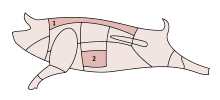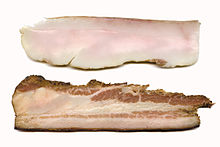Bacon
![]()
This article is about the fatty tissue. For other meanings, see Bacon (disambiguation).
As bacon (since the 10th century in the ahd. documented as spec, cf. also as. spekk, ae. spic, anord. spik, extra-Germanic without s- in lat. pinguis "fat", gr. πῖαρ, ai. pīvas-, doubtful, however, rare lat. spectile "belly fat") is called especially in pigs the fatty tissue, which is located between skin and muscles. A distinction is mainly made between back fat (also fat bacon) from pure fatty tissue and belly fat (also streaky bacon) from pork belly streaked with muscle meat.
![]()
This article or subsequent section is not sufficiently supported by evidence (e.g., anecdotal evidence). Information without sufficient evidence may be removed in the near future. Please help Wikipedia by researching the information and adding good supporting evidence.
In addition, there is also bacon, which is made from the rump, the part of the ham located on the back. The cut, undivided part of the bacon is called the bacon side or bacon rump. Bacon is often sold together with the skin of the pig, the rind, which can also be used separately.
Back fat is used in European cuisine mainly as an ingredient, for example to lard and coat lean meat or to make lard, but also diced, minced or ground in numerous sausages. Pancetta is used partly, bacon mainly as a cold cut.
Back bacon is offered raw and unsmoked as green bacon and, like belly bacon, also cured, smoked, dried and cooked. Breakfast bacon (bacon) is cured and smoked back or belly bacon with portions of underlying meat. Well-known products are belly bacon, square bacon, Jausenspeck, breakfast bacon, lardo, pancetta, guanciale, salo, Black Forest bacon, South Tyrolean bacon (called Speck in Italian for short), Tyrolean bacon and Valais dry bacon (called Schpäkk in Valais German for short).
The layer of fatty tissue, or blubber, of whales and seals is called blubber.

1. back fat 2. belly fat

Top: Smoked back baconBottom : Smoked and whole baked belly bacon
Search within the encyclopedia